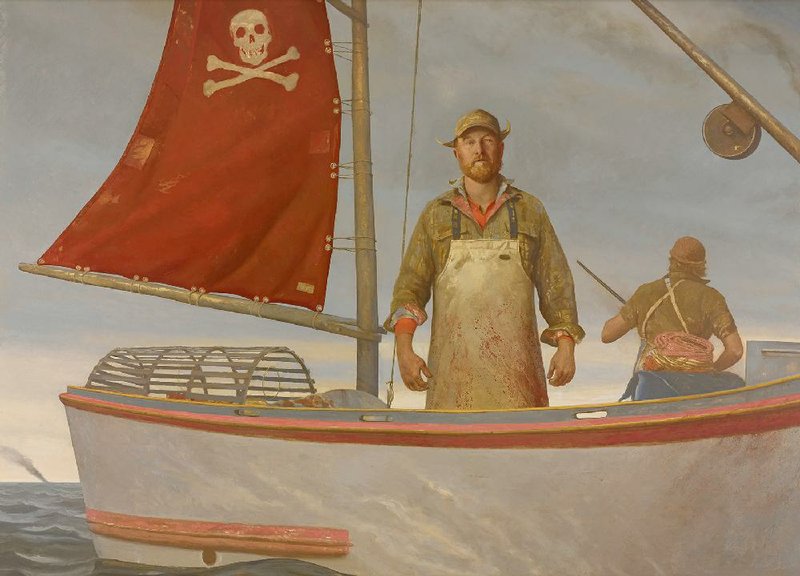BENTONVILLE - Bo Bartlett’s oil-on-linen painting The Lobster Wars (2007) has a menacing vibe.
From the stern look on the boat captain’s face to the blood on his vinyl apron and the skull and crossbones on the ship’s sail, one gets the impression he and his crew mean business.
And they did, says Bartlett, whose painting is in Crystal Bridges Museum of American Art’s permanent collection and on display in the museum’s 20th-century gallery. He met and befriended the boat captain after antagonistic lobstermen shot at his turn-of-the-century summer home on an island off the coast of Maine as an act of intimidation. Bartlett tied a white T-shirt on the end of a tree branch and offered it up in surrender.
Bartlett will be in Arkansas this week for a screening Friday night of his most recent film SEE: An Art Road Trip and to attend the museum’s spring party, Art Night Out, scheduled for Saturday. Both events are at Crystal Bridges and are open to the public. The screening is free, but registration is required. Tickets to Art Night Out are $20 ($16 for museum members).
SEE premiered in October at the Camden International Film Festival in Maine and has had limited showings since. What was shown at Camden was a working version of the film, said Glenn Holsten, an independent film editor whose work on SEE resulted in the final product.
Bartlett, 58, and his wife, Betsy Eby, also an artist, had been talking about making the film almost as long as the decade they’ve been together. They initially intended to make a movie about a cross-country road trip and the art and characters they encountered along the way. While on the road, Bartlett suffered a health problem that affected his sight, and their travelogue came to include Bartlett’s hospital stay.
“It’s part love story, part road trip, part art history lesson and part existential journey,” says Bartlett.
The life-altering health problem has since been corrected.
Eby said, “As the story unfolded, our own life story unfolded, and as it turned out, it was a more gripping plot point than anything we could’ve made up.”
The couple recorded hundreds of two-hour videotapes. Bartlett then took the next two years to edit it himself. He had a painting suite and an editing bay in different corners of his then-West Coast studio.
He said his two-plus-hour version was full of long, static, artful shots.
Holsten went back through the raw footage and substituted the end pieces of various shots, such as the beginnings of takes where Bartlett was bringing the camera into focus.
The result was a 72-minute film full of energy and life, Bartlett said.
“Instead of being perfect, it became all about being imperfect,” he said.
Jacob Dowling of Dowling Walsh Gallery in Rockland, Maine, said the film was well-received at the Camden film festival.
“It comes across as this really genuine approach to film,” says Dowling, Bartlett’s dealer in Maine. “It makes [Bartlett and Eby’s] point, which is that people can look at things without really seeing them.”
Bartlett moved from Seattle to his hometown of Columbus, Ga., about a year ago. He paints there and also at his summer home on an island in Maine every May to October. It’s where he got his inspiration for The Lobster Wars and other sea-themed works, such as his monumental painting Leviathan. Some other paintings from Bartlett’s career so far include Hiroshima (1994), Civil War (1994), God (1990) and Goddess (1997).
His figurative paintings are large-scale and often pull from personal experiences. He uses family and friends as subjects. His style is inspired by Edward Hopper, Thomas Eakins and Andrew Wyeth, who was Bartlett’s longtime friend and mentor.
“Like Wyeth, he’s very mainstream, but not typical of what is the most-cutting-edge or radical art being made,” says Wendy Olsoff with PPOW Gallery, the artist’s New York dealer. In the field of painting, which has been mined by many artists over hundreds of years, he’s producing new works and is an inspiration to other, young artists, she says.
“I think Bo fits in this role or niche where he’s really holding the ground of a figurative painter in a traditional way of portraying the American landscape now,” she said.
David Houston, former director of curatorial at Crystal Bridges and now executive director of the planned Bo Bartlett Center in Columbus, had not yet arrived at the Bentonville museum when The Lobster Wars was acquired. He calls the work “a classic Bo piece.”
Houston has a penchant for opening new arts institutions such as Crystal Bridges and The Bo Bartlett Center.
The Bartlett center, to be on the River Park campus of Columbus State University, will be a permanent gallery and learning center with a focus on contemporary art. Houston said the institution downtown will house the largest single holding of Bartlett’s paintings, as well as drawings and Bartlett’s complete archive of sketchbooks, correspondence, journals, photographs and other memorabilia.
The center also will exhibit works by artists that inspired Bartlett and some by his contemporaries.
Bartlett trained in Italy before earning a certificate in fine art from Pennsylvania Academy of the Fine Arts in Philadelphia.
Arkansas, Pages 12 on 04/21/2014
